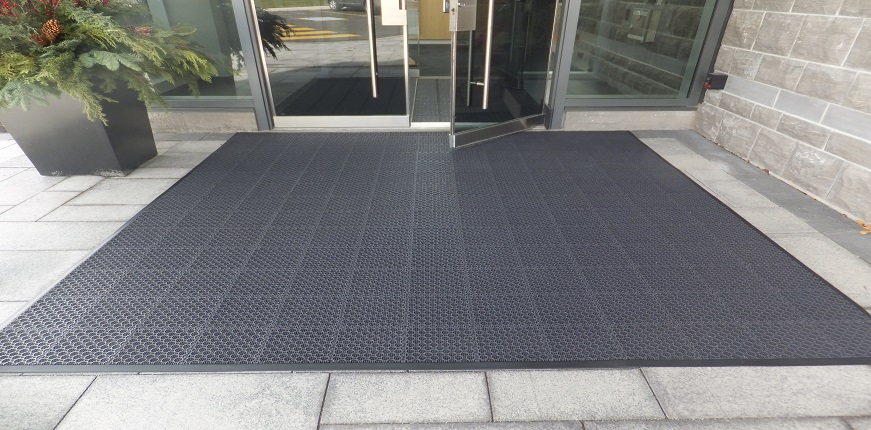
Making the Most of your Mats
MAKING THE MOST OF YOUR MATTING SYSTEM
There is more to effective matting than simply putting mats at the doorway. A proper system with the right product can reduce the transmission of dirt, moisture and debris by 80% or more.
Before placing any mat on the floor, ensure the surface area is clean and dry. What sits below the mat will affect its ability to protect the floor and reduce damage and slipping.
For optimal performance from your entrance mat, it should be long enough for pedestrians to take a minimum of 3 full steps on them before walking off (3 steps on each foot). This allows the matting enough time to pick up loose dirt and moisture.
Matting should be looked at in 3 segments – the ‘primary mat’, meaning the first mat, usually a scrub type mat that pedestrians cross, the ‘secondary mat’, the typical entrance mat, just inside the door, and the ‘specialty’ or transitional mats for interior areas that develop debris.
A primary scrub mat directly before your entrance door, outside or in mat wells, can reduce the load of debris crossing the threshold by up to 40%. Scrub mats grab loose grit, salt and larger debris, and some moisture. Avoid solid rubber scrub mats outside as they can hold moisture between the mat and the ground causing damage and creating an unpleasant odour. Rubber can also wear out prematurely, particularly in harsh weather. For this purpose, a good quality PVC system that allows moisture to channel away is a much better choice.
A secondary, or entrance mat, should be as absorbent as possible. To quickly find out if your current mats are absorbent and working properly, do the water test: Step in a small amount of water – just enough to cover the soles of the shoes – then wipe your wet shoe on the mat 3 or 4 times. When done, step on a clean piece of paper. If a shoe print is clearly visible on the paper, the mat is not absorbent and will allow moisture to transmit past it.
Slowing foot traffic down through the entrance way is also a great way to get the most effective use of your entrance matting.
- Where there are two sets of doors, try to offset the access so that pedestrians have to zig-zag in. This gives them more time on mats in the vestibule areas and allows the mats more time and more steps to catch and absorb debris. This also reduces wind-flow through the vestibule area, saving on heating costs
- Create a ‘calming’ zone by adding a plant feature or some other object that slows down or diverts the pace at which people walk. Slower steps means more steps on the mats. This technique is often used in retail stores about 8’ – 10’ inside the doors to get people to slow down and shop/browse by use of a feature table or sale sign.
Keep doors closed as much as possible—especially in the colder months. This slows pedestrians down and helps to maintain ambient temperatures in lobby and common areas. In the summer, it helps reduce dust and dirt from blowing in. Dust, dirt and sand can cause significant damage to your floors as they act like sandpaper on the bottom of shoes. Many facilities remove most of their matting in the warmer months, exposing the floor surfaces to this abrasive damage.
Air-borne dust that settles on products, furniture and sensitive electronic equipment can be tracked back to floor dust that is tracked in then ‘blown’ into the air due to a lack of effective matting to hold it down. Because of this, avoid cleaning equipment like brooms or vacuums that use aggressive scrubbers. Warm water extraction is the best and safest way to reduce the spread of air-borne dust. Also, use a mat that has good static-electricity characteristics, particularly tufted fabrics like microfiber that act like a dust magnet.
For interior transitional zones, specialized matting is key in debris transmission and floor protection but is often overlooked. Parking garages and side entrances sometimes get more traffic than main entrances, and are often the culprit in the spread of dirt. Social rooms, gymnasiums and pool areas are also common areas where debris gets transferred through buildings.
Washroom areas, particularly in restaurants are a leading contributor of germs and debris. Washroom matting at urinals, hand dryers and sink areas not only slow the spread of contaminated moisture from foot traffic, they provide a safe, slip preventative protection for patrons.
Also, don’t forget about mechanical areas such as escalators and elevators. A mat just before these can help reduce expensive repair and maintenance costs by catching debris and preventing it from becoming entangled in gears and motors.

